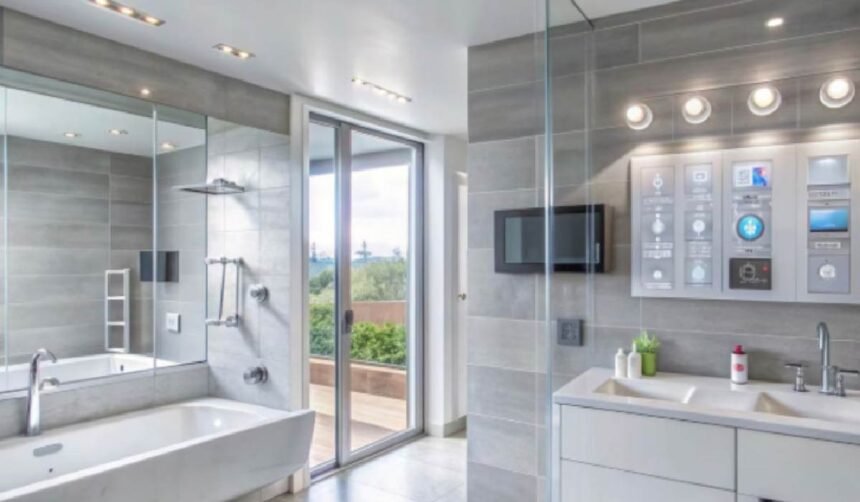Manhattan bathroom renovations present unique challenges that distinguish them from suburban projects. Space constraints, building regulations, and premium material costs create a complex landscape requiring careful planning and specialized expertise.
Your Manhattan bathroom likely measures between 35-60 square feet, demanding creative solutions that maximize functionality without sacrificing style. Unlike larger suburban bathrooms where layout flexibility abounds, Manhattan renovations must work within existing plumbing locations and structural limitations that significantly impact design possibilities.
Building regulations in Manhattan add layers of complexity absent in other markets. Co-op and condo boards maintain strict approval processes, while Department of Buildings permits require detailed documentation for even minor modifications. Understanding these requirements prevents costly delays and ensures your project proceeds smoothly.
This comprehensive guide addresses every aspect of bathroom remodeling in Manhattan from initial planning through final installation. You’ll discover space-maximizing design strategies, navigate building approval processes, and learn cost-effective approaches that deliver luxury results within Manhattan’s challenging parameters.
Understanding Manhattan’s Unique Bathroom Challenges
Space Optimization in Compact Areas
Manhattan bathrooms demand innovative design solutions that suburban renovations rarely require. Every square inch matters when working with spaces that often measure just 5×7 feet or smaller. Traditional bathroom layouts simply don’t translate to Manhattan’s spatial constraints.
Wall-mounted fixtures create visual space by exposing floor area beneath toilets and vanities. This approach makes small bathrooms appear larger while providing easier cleaning access. However, wall-mounted installations require additional structural support that may necessitate wall modifications.
Corner installations maximize floor space utilization in square or nearly square bathroom layouts common in Manhattan apartments. Corner toilets, sinks, and shower units free up the central floor area for movement while maintaining full functionality.
Building Code and Permit Requirements
Manhattan bathroom renovations require Department of Buildings permits for most modifications beyond simple cosmetic updates. Even moving fixtures by a few inches triggers permit requirements that add weeks to project timelines if not planned properly.
Plumbing permits become mandatory when relocating water supply lines or drainage systems. Manhattan’s aging infrastructure often requires upgrades to meet current codes when existing systems are disturbed during renovations.
Electrical permits are required for new lighting circuits, ventilation fans, or heated flooring systems. Licensed electricians must perform this work, with inspections required before final approval. Planning electrical modifications early prevents delays during construction phases.
Co-op and Condo Board Approvals
Most Manhattan buildings require board approval before renovation work begins. Alteration agreements detail permitted work hours, construction requirements, and restoration obligations that protect other residents from disruption.
Board review processes typically require architectural plans, contractor insurance certificates, and detailed construction schedules. Some buildings mandate specific contractors or require additional insurance coverage beyond standard policies.
Security deposits ranging from $2,000 to $15,000 ensure proper cleanup and building protection during construction. These refundable deposits tie up funds during renovation periods but prevent work stoppages if building damage occurs.
Design Strategies for Manhattan Bathrooms
Maximizing Visual Space
Light colors and reflective surfaces create illusions of expanded space in compact Manhattan bathrooms. White, cream, and pale gray tiles reflect available light while making walls appear to recede. Glossy finishes amplify this effect but require more frequent cleaning.
Large-format tiles reduce grout lines that can make small spaces appear busy and cramped. 12×24 inch or larger tiles create cleaner sight lines that enhance spatial perception. However, larger tiles may require perfect substrate preparation to prevent cracking.
Frameless glass shower enclosures eliminate visual barriers that make bathrooms feel divided and smaller. Clear glass maintains sight lines across entire bathroom spaces, while semi-frameless options provide structural support at lower costs.
Storage Solutions for Small Spaces
Built-in storage maximizes every available inch without protruding into walkways. Recessed medicine cabinets, shower niches, and wall-mounted cabinets provide necessary storage while maintaining clean lines that enhance spatial flow.
Vanity selection significantly impacts both storage capacity and visual space. Floating vanities create floor visibility that makes rooms appear larger, while traditional vanities often provide more storage volume. The choice depends on individual storage needs versus spatial priorities.
Vertical storage solutions utilize wall space that might otherwise remain unused. Tall, narrow cabinets and shelving units draw the eye upward while providing significant storage capacity without consuming precious floor area.
Lighting Design for Compact Bathrooms
Layered lighting creates depth and functionality in small Manhattan bathrooms. Ambient lighting provides general illumination, task lighting serves specific activities, and accent lighting adds visual interest that makes spaces feel more sophisticated.
Mirror lighting requires careful planning to eliminate shadows while providing flattering illumination for grooming activities. Side-mounted sconces typically provide better light distribution than single fixtures mounted above mirrors.
Natural light enhancement through privacy film or translucent window treatments maintains daylight access while ensuring privacy. Even small amounts of natural light dramatically improve the perception of space in compact bathrooms.
Material Selection and Costs
Tile and Surface Materials
Porcelain tiles offer durability and water resistance essential in Manhattan’s high-humidity bathroom environments. Premium porcelain tiles range from $8 to $25 per square foot, with installation adding $10 to $15 per square foot depending on complexity.
Natural stone provides luxury appeal but requires sealing and maintenance that some Manhattan residents prefer to avoid. Marble and travertine create stunning visual impact but cost $15 to $40 per square foot plus installation and ongoing care requirements.
Luxury vinyl tile (LVT) offers realistic stone and wood appearances at a fraction of natural material costs. High-quality LVT ranges from $4 to $12 per square foot installed and provides excellent water resistance with minimal maintenance requirements.
Fixture and Hardware Costs
Space-saving fixtures command premium prices due to specialized engineering required for compact installations. Wall-mounted toilets cost $400 to $1,200 plus installation, while standard floor-mounted units range from $200 to $800.
Compact vanities designed for small spaces typically cost more per square foot than standard sizes. Custom vanities measuring 24 inches or less often cost $800 to $2,500, while semi-custom options range from $400 to $1,200.
High-efficiency fixtures reduce water consumption important in Manhattan’s sustainability-conscious market. Low-flow toilets, water-saving showerheads, and sensor-activated faucets may qualify for utility rebates that offset premium pricing.
Construction and Labor Considerations
Manhattan-Specific Construction Challenges
Material delivery in Manhattan requires specialized logistics that impact project costs and timelines. Freight elevator reservations, street parking permits, and hand-carrying materials up multiple flights add complexity absent in suburban projects.
Noise restrictions limit construction hours in most Manhattan buildings. Work typically must occur between 9 AM and 5 PM on weekdays, with weekend and evening work prohibited. These restrictions extend project timelines compared to unrestricted suburban renovations.
Dust control becomes critical in Manhattan’s shared living environments. Proper containment systems prevent dust migration to neighboring units, while HEPA filtration systems maintain air quality during demolition and construction phases.
Professional Services and Permits
Licensed contractors experienced with Manhattan regulations command premium rates but prevent costly mistakes that inexperienced contractors often make. General contractors typically charge 20-30% above suburban rates, reflecting specialized expertise and logistical challenges.
Plumbing and electrical work requires licensed professionals in Manhattan. Master plumbers charge $150 to $250 per hour, while licensed electricians command similar rates. Permit fees add $200 to $800 depending on work scope and complexity.
Architectural services may be required for structural modifications or complex layout changes. Architects charge $200 to $400 per hour, with typical bathroom projects requiring 10-20 hours for plan development and permit applications.
Budget Planning and Cost Management
Realistic Budget Ranges
Basic Manhattan bathroom renovations focusing on cosmetic updates typically cost $15,000 to $30,000. These projects include new fixtures, tiles, paint, and lighting without major layout changes or plumbing modifications.
Mid-range renovations involving layout changes, premium materials, and upgraded fixtures range from $30,000 to $60,000. These projects often include custom vanities, high-end tiles, and improved lighting systems that transform bathroom functionality and appearance.
Luxury bathroom renovations in Manhattan frequently exceed $60,000 and can reach $100,000 or more for high-end materials, custom millwork, and extensive structural modifications. These projects create spa-like environments with premium fixtures and finishes.
Hidden Costs and Contingencies
Structural discoveries common in older Manhattan buildings can add unexpected costs to renovation budgets. Plumbing upgrades, electrical improvements, or structural repairs may become necessary once demolition reveals existing conditions.
Building compliance issues sometimes surface during permit review processes. Code violations or required upgrades can add thousands to project costs if not identified during initial planning phases.
Extended construction timelines due to material delays or permit issues can increase labor costs and extend temporary living arrangements if alternative bathroom facilities aren’t available during construction.
Timeline and Project Management
Planning Phase Duration
Design development and permit acquisition typically require 6-12 weeks before construction can begin. Board approvals add 2-4 weeks to this timeline, while Department of Buildings reviews can extend timelines if revisions are required.
Material selection and ordering should occur during permit review periods to prevent construction delays. Custom items like vanities or specialty tiles may require 8-12 weeks for fabrication and delivery.
Contractor selection requires careful vetting of Manhattan experience, insurance coverage, and building approval status. Experienced contractors often book 4-8 weeks in advance during busy seasons.
Construction Timeline Expectations
Manhattan bathroom renovations typically require 3-6 weeks for completion, depending on scope and complexity. Simple cosmetic updates may finish in 2-3 weeks, while major renovations involving layout changes require longer timeframes.
Inspection schedules can impact construction flow if inspectors aren’t available when needed. Planning inspection requests well in advance prevents work stoppages that extend project timelines.
Final details like fixture installation, tile grouting, and paint touch-ups often take longer in Manhattan due to dust control requirements and building access restrictions that slow material movement.
Transform Your Manhattan Bathroom Today
Bathroom remodeling in Manhattan success depends on understanding the city’s unique challenges while maximizing every design opportunity. Your compact space can become a luxurious retreat with proper planning, experienced professionals, and realistic budget expectations.
Start your project by consulting with Manhattan bathroom specialists who understand building requirements and space optimization strategies. Obtain detailed quotes that include permit costs, building fees, and contingency allowances for unexpected discoveries.
Remember that Manhattan bathroom renovations are investments in daily comfort and property value. Quality materials, professional installation, and thoughtful design create lasting improvements that enhance your urban lifestyle while maintaining your property’s competitive position in Manhattan’s demanding real estate market.
Contact Info:
Name: Jsm Custom Remodels
Address: 205 Hudson St #730 New York, NY 10013
Phone: +13473055961
Email: info@jsmcustomremodels.com
Website: https://jsmcustomremodels.com/









